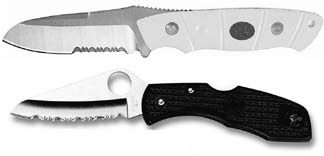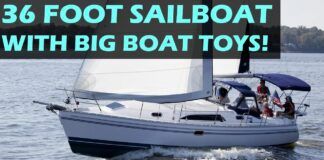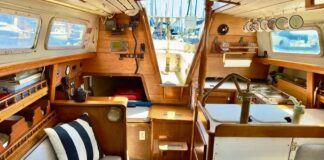There can be no overstating the importance of a good knife to a sailor. It does everything from routine maintenance to saving life and property. Not only should every sailor carry a knife on his belt or in his pocket, but sharp knives should be strategically located around the boat to grab in emergencies. Whether you prefer the speed of a sheath knife, the convenience of a folding pocket knife, or the versatility of a multi-tool, don’t leave the dock without your own blade.

We last evaluated nautical knives in June, 2000 (“Sailors’ Knives: 14 High-End Blades Tested”). In that review, the Boye Dendritic Cobalt knife was a clear winner. In the years since, sectors of the knife industry have enjoyed a large increase in demand by the federal government for tactical, combat, and EOD (explosive ordnance disposal) models. This new business, and accompanying R&D, create product improvements of interest to us, e.g., greater corrosion resistance, lighter knives, and sheaths not only more suitable to the marine environment but wearable in varied positions. Thus, we thought it would be time to revisit both the knife market and the selection criteria that sailors might apply to knife purchases.
How We Selected the Knives Tested
We didn’t retest models that hadn’t substantially changed since our review in 2000, except to revisit two models that previously scored low. (Both appear to be unchanged.) Otherwise, the Boye knife and others that scored well in that review still receive a hearty recommendation. However, since the field is so large, we needed to sample further.
As we did in our last review, rather than limit our view to the chandlery shelf, we picked knives on the basis of usefulness over a wide range of tasks. At the same time we ratcheted the high end up a click or two compared to last time, while not rejecting entries on the basis of low cost alone.
We had considerable variety from which to choose, so consider the models here as representative of classes rather than unique. The attributes table lists variations available within each model.
Practical Sailor‘s Knife Evaluation Criteria
To help you select a knife that you’ll find interesting and useful enough to carry every day, we provide a range of criteria and choices rather than simply a winner, although we do name what we would buy, based on our own criteria. You decide what’s important to you and make your choice. The performance table lists the ratings.
Cutting. To simulate an emergency we tried for one-stroke cuts using the full length of the blade and, as near as possible, the same pressure on the stroke. We used 7/16″ Sta-Set Polyester Yacht Braid, and 1/2″ polypropylene rope, the latter exuding a slight chemical sweat that reduces the bite of the blade.
Serrated edges usually have an advantage in such tests, but some plain edges were equally effective. Longer blades can compensate, but some short blades did amazingly well.
Portability. Think of this as a measure of how easy the designer/manufacturer has made it to follow our recommendation that you carry your knife at all times. Most folders will do better here, but this was not a given with all models.
Deployability. How easy is it to get the knife from its carried position to a using position-and to put away again.
Absence of magnetic influence. We observed how a compass reacted to each knife when brought into proximity with it.
Corrosion resistance is largely indicated by the percent of carbon in the alloy, but is also influenced by chromium, nickel and nitrogen, and heightened by coatings. Titanium is generally immune to corrosion.
Knives for Sailors Reviewed
[Dimensions, materials, features and other aspects not reported here are listed in the accompanying table. ]Benchmade #100SH20. This fixed-blade model of low-carbon, high-chromium H1 stainless steel is claimed to be “impervious to the elements and 100% corrosion resistant.” H1 is a precipitation-hardened steel whose nitrogen content substitutes for the missing carbon, and doesn’t require heat treatment. The steel is further discussed under the Spyderco Salt I model below.
The sheathed knife can be carried on the belt point-down, point-up, or sideways, or it can be lashed to one’s arm, leg, or vest. A secure locking mechanism prevents loss. We found it comfortable to wear, especially in the conventional point-down manner, and convenient for drawing and replacing the knife with one hand. As with all Kydex sheaths, however, using it makes a little noise.
Benchmade Nimravus #140HSSR. We chose this second fixed-blade model from Benchmade chiefly to try its new M2 high-speed tool steel blade. Its sheath is now similar to the 100SH20’s. This medium-size model offers effective grip, and a full-tang blade that’s Teflon-coated to protect its high-carbon, low-chrome tool steel that also contains significant amounts of tungsten and vanadium.
We recommend the optional 100SH20-like belt attachment to bring the Nimravus’ handle closer to the body during belt-carry.
Benchmade #770BC1. This is a gent’s knife: it’s scaled down in most respects, smooth in the hand, has some exotic materials (carbon fiber scales, boron carbide-coated 154CM stainless steel blade), and would look at home with a business suit-yet, for all that, it still offers some tactical qualities.
Boron carbide is one of the hardest materials known, and the blade coating improves scratch and chemical resistance while imparting a shiny gunmetal color that not only complements the grayish scales but would look great on a Porsche.
Benchmade AFCK #806SD2. The venerable AFCK has been improved yet further. Benchmade replaced the former liner lock with the excellent Axis lock, made the clothing clip more versatile, and replaced Teflon pivot bushings with phosphor-bronze. The only take-away is the replacement of the thumb-friendly circular opening hole with an elliptical one which, in the black Teflon-coated model, is so smooth that your thumb tends to slip off during opening.
The former 154CM stainless has given way to D2, an ultra high-carbon, medium-chromium tool steel that’s coated for corrosion resistance. Compared to the previous AFCK blade, this one is much sharper.
We’ve kept a Benchmade with Axis lock in regular use now for four years, and have found no discernible wear or looseness in the lock.
Benchmade #942SBT. Somewhere between a full-size and a gent’s knife, this model offers some of the best of both: light weight, Axis lock, combo edge, clothing clip, innovative bead-blasted aluminum scales that provide excellent grip, and a color-anodized serrated titanium back spacer. The Teflon-coated, 154CM high-carbon, high-chromium stainless, reverse-tanto blade matches the subdued non-reflective black handle, making it correct for evening wear but also tactically capable. It’s a knife that will keep you trying to classify it.
Emerson SARK-BTS. Designed “specifically for emergency-use situations where safety and effectiveness are equally important,” the Search And Rescue Knife is an issue knife for Navy rescue teams. It’s distinguished by its hawkbill blade shape and rounded tip.

When needed, deployment can be dramatically accelerated by using the patented Emerson “wave” opening feature: a small wave-shaped hook formed in the spine of the blade just behind the opening disk: it catches on the pocket corner, and operates faster than a switchblade because the knife opens as it’s being drawn. To activate the wave feature, pull the knife back and down as you’re pulling it out of the pocket, while keeping your middle finger along the handle. For normal opening, pull the knife upwards and, as an additional measure, make sure your middle finger stays on the spine of the blade, which is where it would tend to be anyway. The wave feature requires some practice to master, but we consider it worth the small amount of effort needed to acquire the new muscle memory.
Edge serrations are of the unusual two-level type, like shark teeth, to maintain cutting ability longer. We were able to disassemble/reassemble the knife easily with a Leatherman tool.
Overall the SARK is an impressive combination of innovation, strength and safety.
Fllkniven U2. For fans of the traditional pocket knife, we include this “non-frightening urban folder” from a small Swedish company (pronounced “Fell-k’neeven”). Its blade is of laminated steel. Laminating is an ancient technique for making blades that are both sharp and tough. Laminated blades function in a way similar to a pencil of wood and lead: the soft wood sheath provides damping qualities for the writing core, which would otherwise break easily. The U2’s hard inner core is a powder-metallurgy steel, and the softer outer layers are 420 stainless.
If you’re going to stick with a traditional pocketknife, we believe it should have a locking blade, and should have exceptional cutting ability, and the U2 certainly does. It’s like having a 1-1/2- oz. folding, locking scalpel in your pocket.
Mission Knives #MPK. Mission produces serious work knives, chiefly of titanium, and sold mainly to military units that operate in/around salt water. High-strength titanium alloys have qualities most knifemakers want-wear and corrosion resistance, toughness, flexibility, and tensile strength. However, they’re difficult to work, hard on production equipment, and five times the cost of the best steels-so only a few specialty makers use it, and the end product is fairly expensive. Extensive research has yielded the capability to harden certain types of titanium alloys to about Rc 46-47, which seems soft compared to the steels of the other knives-until you use it.
Quite light for its size-titanium weighs 40% less than steel-this 10″ knife will not corrode in salt water, and has no magnetic signature, so it won’t affect a compass. The handle seems at first to lack surface treatment for grip, but it’s designed to be kind to hands that have been softened by long immersion in water. The sheath isn’t noisy, and its surface has enough grip to retain the knife without a keeper. An integral-handle version (MPS) and a folder (MPF) are also available.
Myerchin Offshore System #A508. In about 1984, John Myerchin produced the A500, a full-tang, fixed-blade version of the traditional rigging knife, eliminating the need for a folder’s pivot and lock. The A508 is a combo that includes an A500 integral-handle (no scales) version of the original, and a separate A008 fid/marlinspike, in a ballistic-cloth sheath with a compartment for each. Its thick blade has a sand-blasted handle, an index-finger cutout, and thumb lugs on a portion of the spine. The handle has a 1-1/2″-long shackle-keyhole, which also improves the balance of this all-steel model.
The black sheath supports point-down, point-up and sideways carry, and four eyes allow lashing to gear or body parts. The polished 6.9″ marlinspike is secured by a nylon keeper through a .8″-long shackle key hole at its wide end.
Myerchin Shark #A566P. This is an auxiliary/back-up version of their A500, with a neck sheath for quick draw. We found it comfortable to wear around the neck, but it can also be carried point-up or point-down on the belt, or lashed via six eyes. In view of the Shark’s smallish handle , the shackle key hole has been moved out to mid-blade.
One useful feature that should have been carried down from the A500, but wasn’t, is the sand-blasted handle. Instead, you have a mere 2″ of thin, polished steel to grasp in order to draw the knife. We’d recommend having this surface treatment done if you buy this knife.
SOG Flash II #STGFSA-98. Named after a Vietnam-era covert operation group, SOG Knives has since 1986 produced an expanding line of fixed-blade and folding knives as well as a variety of multi-tools. This folder is built around the technology of assisted-opening: initiate the opening sequence normally, using the stud on either side of the blade, and an internal mechanism finishes the job, including locking the blade open. Two controls are provided: a safety, which firmly locks the blade closed; and a release, which frees up an open blade for closing. Closing is not assisted.
Handle expansion at the pivot end, as well as cutouts and other lugs, enhance grip. Since the lock release operates by pulling it away from the blade, forward pressure on the handle won’t allow the blade to fold on your hand by mistake.
Assisted opening is probably a feature you’ve never tried. Since it’s the only way to open the Flash model, we suggest a hands-on session to find out whether it’s for you.
SOG SEAL Pup #M37. In 2000, SOG successfully competed with 13 other manufacturers to be a supplier of knives for West Coast Navy SEAL teams. The SEAL Pup is a scaled-down version of that fixed-blade knife.
Its blade has a generous choil, which allows choking up on the blade with the index finger in front of the hilt. The handle has an integral hilt, finger cutouts, thumb rest, and a sharply knurled grip surface.
Numerous loops, slots and eyes on the sheath allow carrying in several positions, including inside the belt. It’s tough, versatile-and noisy, as others of the type are. (The Navy-contract knives call for web sheaths.)
Spyderco Assist #C79PS2. This model features two crescent-shaped dips on the back of the blade for placement of the index finger during close work. The bulky, linerless handle is equipped with Bi-Directional Texturing (see D’Allara model below) and four deep finger cutouts, offering exceptional grip even in the water. Built into the handle is an emergency whistle. The Assist can also be used in a kind of scissoring motion for rope cutting: the rope is laid across the second finger cutout and the blade closed down on it.

Spyderco DAllara Rescue #C82SBK.Named to commemorate the late NYFD officer John D’Allara, this robust new folder employs a large spring-loaded ball bearing to lock the blade; it also allows the blade to be safely unlocked and closed without placing any fingers in front of the edged part of the blade. Although not a new feature, Spyderco’s Bi-Directional Texturing is more aggressive here, and should provide secure grip even underwater, resisting slipping in either direction by means of asymmetrical lugs cleverly molded into the scales. Stainless liners add strength to both lock and blade.
Its blade is of VG-10, a high-carbon, high-chromium steel also containing cobalt and vanadium. A large circular opening hole, one of Spydercos long-term signature features, makes the knife easy to open.
Spyderco Dodo #C80GSBL. Imagine a folder that seems to have been molded to fit a closed hand, with a short oddly shaped blade that stylists would probably reject out of hand, and you have the Dodo.
Starting from the outside in, the Dodo’s handle has finger cutouts including a 50-50 choil for the index finger. Locking is by means of Spyderco’s recent ball-bearing lock, also ambidextrous-although you’ll probably use a two-hand closure unless you have strong thumbnails.
The stubby blade is made of CPMS30V, an ultra high-carbon, high-chromium, high-vanadium powder-metallurgy stainless steel. Its reverse-S shape ends in a downward-pointing tip that excels in penetration. Ergonomic design and modern materials should protect the Dodo from extinction, but its strange (and completely misleading) visual impression could lead some to avoid it. On the other hand its ugliness may prove so seductive that it ought to have been named the Beetle.
Spyderco Rescue 79mm #C14SOR and 93mm #C45SOR. Spyderco’s popularity with firemen and rescue workers is due to a line of sheepfoot-blade knives which began in 1982.
These Rescues both have orange handles and large round opening holes. The humps around the holes have a serrated thumb ramp to apply pressure on the blade and prevent slipping. Their front locks have locking bars with a safety “dent” designed by David Boye for added security. A 50-50 choil formed by the intersection of blade and handle, reduces the likelihood of slipping when choking up on the blade.
These models offer significant cutting power in a small, lightweight and-after 22 years, traditional-format.
Spyderco Salt I #C88SBK. The new Salt I has a larger, 14mm circular opening hole, and is Spyderco’s first knife to feature the new H1 steel, a material which “doesn’t rust.” A similar claim is made for all the other steel parts of the knife. See the discussion of H1 under the Benchmade 100SH20 model.
Whereas low carbon content typically leads to poor cutting performance, Myodo Foundry in Japan has apparently discovered how to achieve hardness with a small amount of nitrogen in the alloy. Heat treatment is, we’re told, not required.
Our cutting tests revealed impressive performance.
West Marine Rigging Knife #3705613. From West Marine we bought this modern all-steel folder with one-hand opening and clothing clip, manufactured in China. Its fully serrated sheepfoot blade is of 420, a low-carbon stainless that we would expect to be noted more for rust-resistance than edge-holding. It’s also highly polished, which helps it resist crevice corrosion, but also makes it slipperier to handle. It was the only knife that failed to cut through the test rope after several strokes. The slim elliptical opening hole is too thin to engage the thumb.
Since we obtained this knife, West seems to have taken it off its shelves-or at least it’s no longer listed online. West offers other knives, including some mentioned here, that are superior to this one.
The Best Knives for Sailors
The “excellent” cutters in both types of rope were the 140HSSR from Benchmade, and the D’Allara and Salt I from Spyderco. If you don’t use rope as difficult to cut as polypro, the following join this group: Benchmade 100SH20 and 806SD2, Emerson SARK, Fllkniven U2, Mission MPK, Myerchin A508, and Spyderco Dodo and Rescue models. Among these, the “excellent” in both portability and deployment were the 100SH20, 806SD2, SARK, the Rescues and the Salt I. To narrow the group further, the two that were the lowest in magnetic influence were the 100SH20 and the SARK-and both of these are in the medium-low price range.
Alternatively, you could select corrosion resistance as your prime criterion. The best here were the Mission MPK, Benchmade 100SH20, and Spyderco Salt I.
For absence of magnetic influence, the MPK is the clear choice.
Fastest in deployment was the Emerson SARK, with its “wave” feature.
If price must be your major criterion, consider the U2 and Salt I-both of which were among the top cutters. If you want an all-round model that rated “good” or better in every category except price, consider the 100SH20, the SARK, and the MPK. Factor in price and you have the 100SH20.
For the greatest number of “excellent” ratings (4), including cutting performance, and their low prices, we nominate as Best Buys the Spyderco Salt I and Benchmade 100SH20, in that order.
Dull knives are dangerous, especially to the user, and all knives, without exception, eventually need resharpening. If you don’t know how to sharpen, don’t hand your fine knife to the guy down the street with a grinding wheel. Return it to the manufacturer, who will probably charge only a nominal fee, plus return postage, to bring back that edge.
Also With This Article
“Knife Attributes and Performance.”
Contacts
Benchmade, 800/800-7427, www.benchmade.com
Boye Knives, 800/853-1617, www.boyeknives.com
Emerson, 310/212-7455, www.emersonknives.com
Fllkniven, 46-921-544-22, www.fallkniven.com
Mission, 714/777-7881 www.missionknives.com
Myerchin, 909/463-6741, www.myerchin.com
SOG Knives, 888/764-2378, www.sogknives.com
Spyderco, 800/525-7770, www.spyderco.com
West Marine, 800/262-8464, www.westmarine.com







































